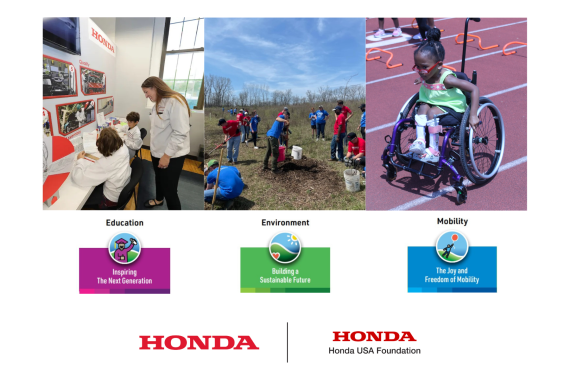Honda Advises Ohio State Supermileage Student Team
In just its first year, Ohio State’s Supermileage student team developed and constructed a single-person vehicle with a fuel-efficiency of 96 mpg. The second year, it more than doubled to 256 mpg. Now in its third year, the team aspires to exceed 500 — maybe even 700 — mpg.
To drive that impressive progress, the students turn toward experts: the team at Honda R&D Americas Inc.
“Due to our team’s focus on engine modifications this year, we have sought a second opinion from members of Honda’s engine research department,” said Supermileage team co-captain Jackie Karl-DeFrain, a junior majoring in mechanical engineering and Chinese. “We’re explaining what we’re doing, and they’re providing feedback.”
The 18-member Supermileage team isn’t Honda’s first partnership with Ohio State, by far.
“Honda and Ohio State have established a long and successful history of partnership and collaboration spanning almost 30 years,” said Mike Wiseman, Honda’s co-director of the Honda-Ohio State Partnership. “A significant result of this partnership was the Ohio State Transportation Research Endowment Program, supporting transportation-related education, research and Ohio State chaired professorships.”
“This endowment is critical for projects from seeding innovative research to helping establish major joint venture capital investments for mobility infrastructure,” said Joanna Pinkerton, Ohio State’s co-director of the partnership.
“This year, the Honda-Ohio State Partnership is taking a new direction with a sharpened focus on innovations in the mobility industry. It matches the university’s efforts to bring smarter transportation solutions to communities in the Buckeye state and, eventually, around the world, with a strong start as the lead researcher for Smart Columbus.”
At Ohio State’s Center for Automotive Research, the Supermileage team came to the attention of Honda engineers.
“We noticed the extensive commitment the students had for motorsports, and the passion the students displayed for vehicles and powertrains was inspiring,” said Dan Nagashima, an HRA principal engineer based in Raymond, Ohio. “We saw it as an opportunity to partner with a great academic institution and create awareness about the work we do here in Central Ohio at Honda.”
Students grow their engineering design and project management skills by applying learned classroom theories in Supermileage, an engineering design competition organized by SAE International, an association of engineers and related technical experts in the aerospace, automotive and commercial vehicle industries.
At last year’s competition in Marshall, Mich., the Ohio State team had one of the most reliable vehicles and completed four successful runs with a ranking of 11 out of 17 vehicles. This year’s SAE Supermileage competition is June 8-9 in Michigan.
The 18-member Supermileage team last year used a small Briggs & Stratton engine — required by the Supermileage competition — that had 206 cc. The students plan to reduce this displacement by roughly a third to limit power output and reduce overall engine friction, Karl-DeFrain said, not wanting to give away her team’s specifics.
“Last fall Honda provided us with one of its motorcycle engines that is a similar size for our end goals. We can look at that and take it apart to better understand how to modify our existing engine,” she said. “What we are doing is minimizing the horsepower of the engine, because we don’t need a lot of power, and we want to limit the fuel consumption.”
The students built the Supermileage vehicle on an aluminum chassis that weighs roughly 50 pounds less than other leading teams in the competition. It has a carbon fiber seat and a steering wheel operated by a push-pull cable.
“Our methodology for running on the track is burn and coast,” said Karl-DeFrain, who drives the car in the competition. “We bring the vehicle up to 25 mph, cut the engine, coast down to 5 mph and then repeat the process. So we’re averaging about 15 mph, which gave us the lowest power usage.”
This year, the team aims to build a fairing, reduce the drag in the drive train and make further engine and chassis modifications.
The factors affecting fuel efficiency are important for students to learn, Nagashima said, in light of the auto industry’s focus on improving fuel efficiency in the last 10 years. And the demands to increase fuel economy continue to grow.
“It’s not just the automobile industry,” Nagashima said, “but a trend you will see in a variety of similar applications like motorsports, locomotives and airplanes, not to mention stationary energy generation and energy conservation in buildings. The Supermileage competition is great, in that it encourages critical thinking and innovation that can benefit energy efficiency in a variety of real-world applications.”
Honda is not only helping prepare future engineers for careers in the transportation industry but also providing continuous professional development for its own employees through collaborations with Ohio State, Wiseman said.
“Partnerships with academia differ from traditional relationships within the industry in that we have the opportunity to look at more fundamental, and at times long range, solutions to our needs, whether those needs are in engineering or business,” Wiseman said.

